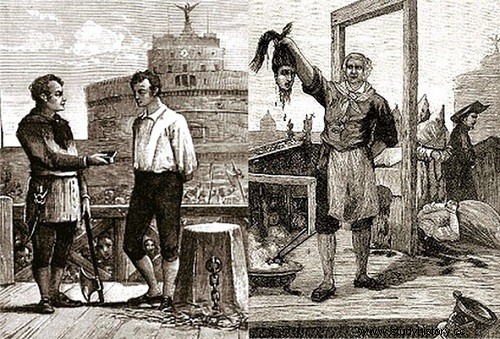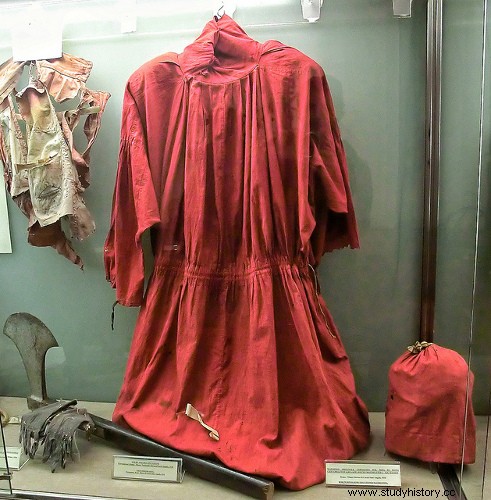Giovanni Battista Bugatti he was the executioner of the Papal States from 1796 to 1865, when he retired at age 85. Also called maestro di Giustizia , from which derives his nickname Mastro Titta . And I say the worst doctor in history because he himself called his victims patients and when he applied his treatments... they all died.
Giovanni put himself at the service of the Church in 1796 and since that date there have been 516 executions with a wide variety of treatments:ax -his favorite-, guillotine, hanging... The number of executions was so precise because Giovanni kept a diary with all of them in which he wrote down date, victim, crime and treatment applied. Between execution and execution, he was distracted helping in the small souvenir shop that his wife had next to his house in Trastevere, on the right bank of the Tiber. It is said that he only crossed Sant'Angelo bridge when he had to go to work on the other side of the river in Campo dei Fiori, Piazza del Popolo and Piazza del Velabro. In fact, some expressions of the time referred to Mastro Titta:“non passare ponte ”, meant that everything was calm and quiet; “passa ponte ”, the executioner crossed the bridge and someone was going to die.

After a year traveling through the towns and cities of Italy, the writer Charles Dickens published Pictures of Italy (1846). A book of daily stories of the towns and people of Italy that includes, and describes, an execution that he attended in Rome and whose executioner was none other than Mastro Titta.
One Sunday morning (May 8) a man was beheaded here. Nine or ten months earlier he had attacked a Bavarian countess on a pilgrimage to Rome […] he stole everything she had from her and beat her to death with her own pilgrim's staff. The man had recently married and gave some of the victim's dresses to her wife, telling her that she had bought them at a fair. But the woman had seen the pilgrim countess pass through the village and she recognized some of her clothes. Her husband then explained what she had done. She told a priest in confession, and four days after the murder the man was arrested.
There are no fixed dates for the administration of justice or for his execution in this incomprehensible country; and the man had remained in jail ever since. […] The beheading was scheduled for a quarter to nine in the morning. Two friends accompanied me. And since we only knew that a lot of people would come, we arrived at half past seven. […] It was a crude object [the scaffold], unpainted, dilapidated in appearance and about ten hands high, on which rose a frame in the form of a gallows, with the blade (an impressive mass of iron, ready to fall ), which shone in the morning sun when it occasionally peeked out from behind a cloud.They struck nine and ten and nothing happened. […] Eleven o'clock struck and everything was the same. Rumors spread through the crowd that the prisoner would not confess; in which case, the priests would retain him until the hour of the Hail Mary (sunset); for they have the merciful custom of not till then removing the crucifix from a man in such a trance, as one who refuses to confess, and is therefore a sinner forsaken by the Saviour. People began to withdraw little by little. The officers shrugged and looked doubtful. […] Suddenly the sound of trumpets was heard. The foot soldiers came to attention, filed to the scaffold and surrounded it in formation. The guillotine became the center of a forest of bayonet points and glittering sabers. People came closer, on the flank of the soldiers. A long river of men and boys who had accompanied the procession from the prison flowed into the clearing.
After a short delay, we saw some monks walking towards the scaffold from the church; and above their heads, advancing with sad slowness, the image of a crucified Christ under a black canopy. They took him to the foot of the scaffold, to the front, and placed him there facing the prisoner, who could see him at the end. She was not in his place when he appeared on the platform barefoot, his hands bound and the collar and neckline of his shirt cut almost to his shoulders. He was a young individual (twenty-six years old), vigorous and well planted. Pale face, dark mustache and dark brown hair. Apparently he had refused to confess unless his wife was going to see him, and they had had to send an escort to look for her; that was the reason for the delay.
He immediately knelt under the blade. He placed the neck in the hole made in a crossbar for that purpose and they also closed it from above with another, just like a pickaxe. Just below him was a leather bag, into which his head immediately fell. The executioner grabbed her by the hair, lifted her up, and walked around the scaffold showing her to the people, almost before you realized that the blade had landed heavily with a vibrating sound. When he had passed all four sides of the scaffold, he placed her on a stick in front of her:a small piece of black and white for the long street to see and the flies to perch on. He had his eyes up, as if he had avoided the view of the leather bag and looked at the crucifix. All vital signs were gone from her. She was dull, cold, livid and pale. And so was the body.
There was a lot of blood. We left the window and approached the gallows, it was very dirty; one of the two men who was pouring water into it turned to help the other lift the body and put it in a box, and he walked as if he were walking through the mud. The apparent disappearance of his neck was strange. The blade had severed his head with such precision that it seemed a miracle that it hadn't severed his chin or sliced off his ears; and it was not seen on his body either, which seemed to be cut flush with the shoulders.No one cared or seemed affected at all. I did not see any manifestation of pain, compassion, anger or regret. My empty pockets were felt several times as we stood in the crowd in front of the scaffold as the body was placed in its coffin. It was a disgusting, dirty, neglected and nauseating sight; It meant nothing but carnage other than momentary interest for the single hapless actor. Yes! Such a sight has meaning and is a warning. […] The executioner, who did not dare, for the life of him, to cross the Sant'Angelo bridge except to fulfill his mission, retired to his lair, and the show ended.

In 1865, Pope Pius IX retired him with a monthly pension of 30 escudos.
If you travel to Rome, don't be surprised if you find restaurants, pizzerias, bars, accommodations... with the name of Mastro Titta, and you can even see his clothes and some of his special treatments in the Museum of Criminology.
Source:«Of the human and the divine«
